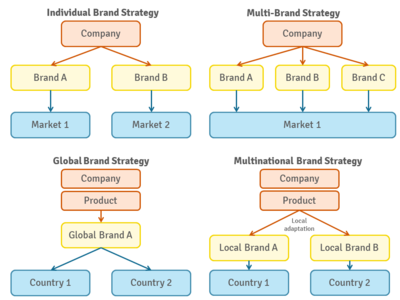Multi brand strategy: Difference between revisions
(The LinkTitles extension automatically added links to existing pages (<a target="_blank" rel="noreferrer noopener" class="external free" href="https://github.com/bovender/LinkTitles">https://github.com/bovender/LinkTitles</a>).) |
m (Infobox update) |
||
| Line 2: | Line 2: | ||
|list1= | |list1= | ||
<ul> | <ul> | ||
<li>[[Diversification in business]]</li> | |||
<li>[[Horizontal diversification strategy]]</li> | |||
<li>[[Tuck-In Acquisition]]</li> | |||
<li>[[Vertical diversification strategy]]</li> | |||
<li>[[Flanker brand]]</li> | <li>[[Flanker brand]]</li> | ||
<li>[[ | <li>[[Market Challenger]]</li> | ||
<li>[[Conglomerate diversification]]</li> | |||
<li>[[Strategic Buyer]]</li> | |||
<li>[[Generic competition]]</li> | <li>[[Generic competition]]</li> | ||
</ul> | </ul> | ||
}} | }} | ||
Revision as of 23:35, 19 March 2023
| Multi brand strategy |
|---|
| See also |
Multi brand strategy is one of a marketing techniques for two or more similar products from one firm but under different and unrelated brands. The idea of Multi brand strategy is to restrict or end the competition and increase the market share.
Main definition
Steven Hillestad wrote in his book that "The multibranding strategy minimizes risk to the parent organization"[1].
"Multibrand strategy permits finer segmantation of the market, with each brand name suggesting different functions or benefits appealing to different buying motives of different customer segments" [2].
The huge thing about Multibranding is that each brand can obtain only a small market share, and not all can be very profitable. The company have to spread a lot off recources over many brands instead building a few brands to a highly profitable level [3].
Multibranding's mission
Primary objective of this is to secure more shelf/display as well as a broader customer base in retail outlets.
Following the assumption if firm wich has two or more brands would sell more than with a single brand and so on to any number of brands, the idea strengthened by the knowledge that every item the company sells, competitors sell one less [4].
Advantages and Disadvantages of Multibranding
The main advanteges are [5]:
- The Multi Brand Strategy is very useful for brand "switchers" companies, which are keeping on changing brands to trying different products, because having a large product line and multi-brand gives a very big chance, that even after switching the brands, the customer is still associated with the company.
- Successes of initial business ensure that the company can now venture into developing another brand with the profits of the first brand or through the way of franchising.
But also here is the main disadvantage [6]:
- The biggest disadvantage of a Multi Brand strategy is that the company's image may become that of not customer oriented but profit oriented and of course this can damage the reputation of the company in long run.
Multibranding in life
A lot of corporations run Multi brand strategy since they have distant brands running in the market on the same time. Here are a few examples:
- BMW: BMW, Rolls Royce, Mini Cooper;
- Adobe: Adobe Photoshop, Adobe Illustrator, Adobe Lightroom, Adobe Stock;
- LVMH: Louis Vuitton, Givenchy, Guerlain, Moët & Chandon, Hennessy and others.
Examples of Multi brand strategy
- Procter & Gamble: Procter & Gamble has multiple brands in the same category, such as Tide detergent, Gain detergent, and Cheer detergent. By offering a variety of brands, P&G can capture more market share and maximize profits.
- Coca-Cola: Coca-Cola has multiple brands in the same category such as Coke, Diet Coke, Sprite, Fanta, and Barq’s. By offering a variety of brands, Coca-Cola can capture more market share and maximize profits.
- Unilever: Unilever has multiple brands in the same category such as Dove, Axe, and Vaseline. By offering a variety of brands, Unilever can capture more market share and maximize profits.
- Nestlé: Nestlé has multiple brands in the same category such as Nescafé, Kit-Kat, and Smarties. By offering a variety of brands, Nestlé can capture more market share and maximize profits.
One of the approaches related to Multi brand strategy is as follows:
- Diversification: Diversification is a strategic move by companies to expand their product portfolio by introducing new brands in different markets or segments. The goal of diversification is to reduce risk and increase profits by taking advantage of new opportunities.
- Brand Extension: Brand extension is a marketing strategy in which an existing brand’s name or image is used to launch a new product in an existing or new market. It is used to capitalize on the existing brand’s equity and recognition, while also leveraging its resources.
- Co-Branding: Co-branding is a marketing strategy that involves two or more brands collaborating to create a unique product or service. The brands involved in co-branding may be related or unrelated, and the collaboration can occur between companies, organizations, or individuals.
- Line Extension: Line extension is a marketing strategy in which a company adds new items or varieties to an existing product line. Line extension is commonly used to introduce new flavors, sizes, or packaging of an existing product.
In summary, Multi brand strategy involves multiple approaches such as diversification, brand extension, co-branding, and line extension in order to increase market share and reduce competition. These strategies enable companies to reach out to new markets and increase their profits.
Footnotes
References
- Bhasin H., (2019) What is Multi Brand Strategy? Types and Examples
- Dabija, Dan-Cristian. (2011). PRODUCER VERSUS RETAIL BRAND STRATEGIES – POSITIONING VECTORS IN CONSUMERS’ MIND. Management & Marketing. 6.
- Durmaz Y., (2016) Brand and Brand Strategies Canadian Center of Science and Education
- Hillestad S., (2004) Health Care Market Strategy: From Planning to Action Jones & Bartlett Learning, pages 168-172
- Kotler P., (2008) Principles of Marketing Pearson Education, pages 530-540
- Kotler P. and others, (2015) Marketing, 9th Edition Pearson Higher Education AU, pages 306-307
- Papantoniou P., (1992) Marketing: The Complete Awakening P.A.S.S. Publications, pages 142-145
Author: Valentyna Ilyina
